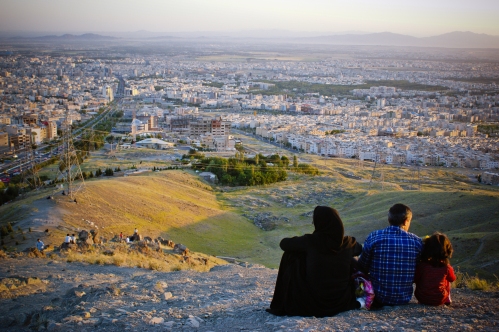
Photograph copyright © Ben McKechnie 2010
You will take taxis in Tehran. That’s a fact. I learned some lessons so that you don’t have to. This article will ruin the fun of finding things out on your own the ‘hard’ way.
Lesson 2 – Please refrain from calling your taxi driver a donkey!
My friend Iman, the gregarious Tehrani, tells the driver to pull up anywhere in the nearby vicinity. The driver informs Iman that that just won’t be possible. The rush hour traffic is becoming increasingly intense as we approach Vanak square in the North of Tehran. The only problem is that Iman has a class starting in ten minutes. We are exactly an eleven minute jog from the school. Iman is the teacher.
He swings open the Paykan taxi door without looking over his shoulder. A second Paykan taxi screeches to a halt, stopping inches away from smashing our door off its hinges. Our driver turns around and, quite venomously, shouts in Farsi ‘YOU FUCKING DONKEY!’ Iman doesn’t take this insult lying down. We both climb out of the cab. He stares the driver straight in the eye and says ‘You, sir, are the donkey!’
This makes the driver look as though he’s going to cry. As if we’ve just double-team french-kissed his grandmother. ‘Take that back immediately!’ he begs. Iman denies this request, replying instead with ‘Your father is a donkey!’. By this point, we are beginning to jog away from the taxi across lanes of rush hour traffic.
The taxi driver is so insulted that he pulls up the handbrake and abandons his vehicle, following us on foot through the flow of traffic. He is desperate to have the insult withdrawn, as if it were an indelible stain to remain upon his person forever. ‘Take that back!’ he screams as he picks up the pace.
By this point, Iman is committed to non-withdrawal. He takes it to the third and final level, shouting ‘You are, your family is, and every single one of your ancestors were donkeys!’
Now I’m running down Valiasr avenue, away from a livid taxi driver, who is removing his belt from his trousers in order to beat us with it. What a bunch of donkeys we are.
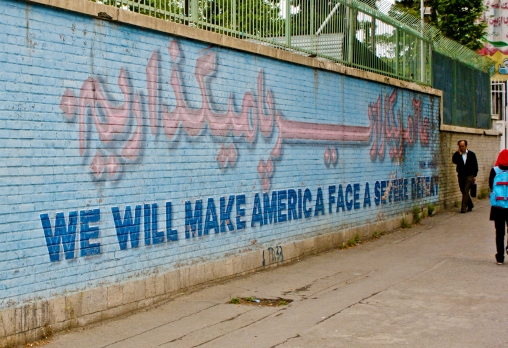
Photograph copyright © Ben McKechnie 2010
You will take taxis in Tehran. That’s a fact. I learned some lessons so that you don’t have to. This article will ruin the fun of finding things out on your own the ‘hard’ way.
Lesson 1 – Don’t slam the doors and expect to get away with it!
My friend Iman, a gregarious Tehrani, enters ahead of me. He lands on the middle seat next to a dazzling beauty with hair like a beehive underneath her hijab. I catapult in and slam the door behind me. The car’s frame reverberates. Outside, the first smatterings of rain hit the windscreen but I find my gaze being drawn upwards until it meets the driver’s in the rearview mirror. His stare holds mine as he speaks. Iman translates. ‘He welcomes a very strong man to his car. It’s not everyday that he has the pleasure of meeting someone with such impressive upper-body strength’. It’s my first taste of Persian sarcasm.
The taxi drivers of Tehran’s Paykan fleet – rusty, trusty automotive relics from the era of the last Shah of Iran – are highly protective of their vehicles. These great hulks of steel lived through the Islamic revolution, the Iran-Iraq war, and the last forty years of wear and tear. You’d be protective too if you relied upon a leaded petrol guzzling antique to keep food on your family’s table.
After he’s said his piece, Iman apologises on my behalf and explains that I’m from the UK. ‘Inglestan?’ An enormous smile spreads across his face, an arm is thrown off the steering wheel and into the air with enthusiastic welcome after enthusiastic welcome shouted. Iman turns to me. ‘He says you are most welcome in Iran and he offers to do anything he can to make your visit more comfortable. He now understands why you closed the door so aggressively. He says he has heard stories of the wonderful taxis you have in London – surely they are able to take that kind of abuse. Please forgive his poor quality car. It is very old and falling apart. He would very much like one of those new Peugeots’. ‘I like old cars very much’, I say.
He drops us at Vanak Square in the north of Tehran. We try five times to press money for the thirty-five kilometre journey into his hands but he refuses each time – going above and beyond the number of attempts required in Iran to give someone a chance to back out without losing face. ‘You are our guest!’ he shouts from the window as he rejoins the flow of cars.
The next day, I close the door of a shared taxi so pathetically out of fear of rebuke, that it causes the taxi driver to comment that I’m surely a feeble-bodied Turk from the city of Tabriz in Iran’s North-West. It seems that there’s a fine line.
When you go to Tehran, try to nail that elusive medium. The textbook closure of a Paykan taxi door.
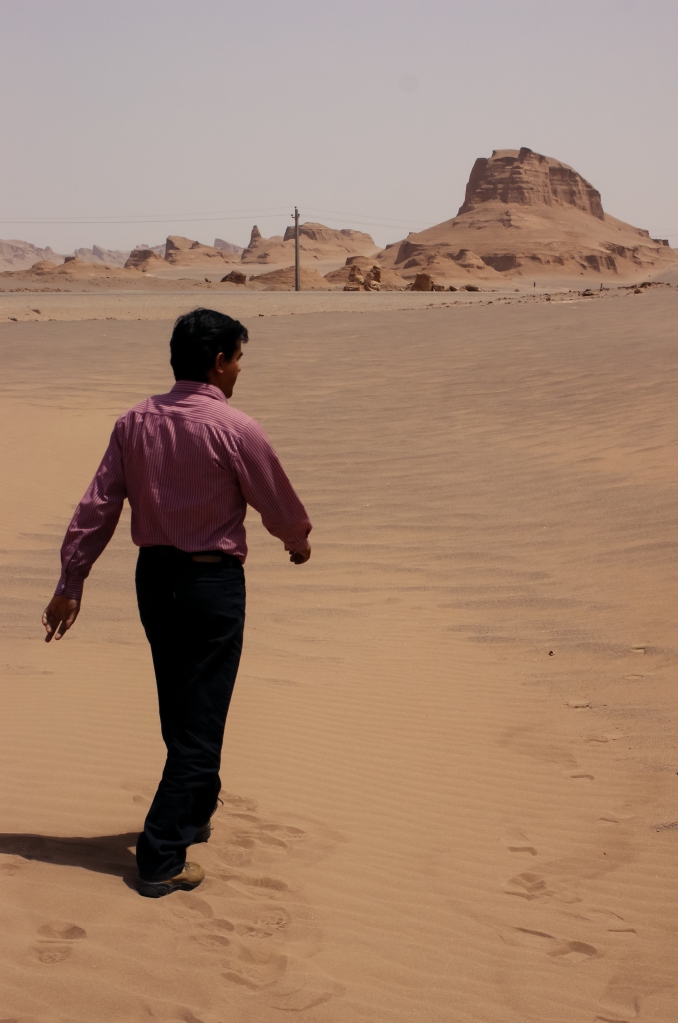
As soon as we stepped outside of the car, we were blasted with intense heat. This was the Kaluts desert (Dasht-e Luts) in South-East Iran, heading for the Afghanistan/Pakistan border. It was one of the most extreme places I’ve ever visited. This feeling was exacerbated by the fact that my hosts were high as kites on opium.
Photograph copyright © Ben McKechnie 2010
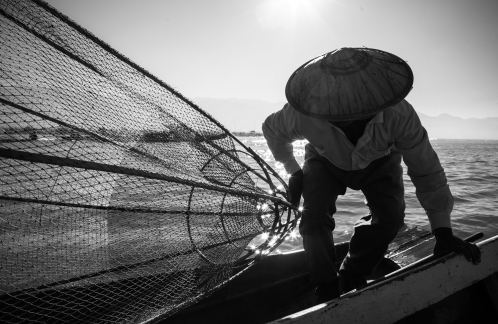
He’s an Intha – a member of a Tibeto-Burman ethnic group living around the lake – famed for their leg-rowing technique and for living off produce grown on floating gardens. Some entrepreneurial fishermen have recently decided that it makes more financial sense to catch one fish in the morning then pose with it for tourist photos at $1 a pop. A lucrative business indeed.
Photograph copyright © Ben McKechnie 2014
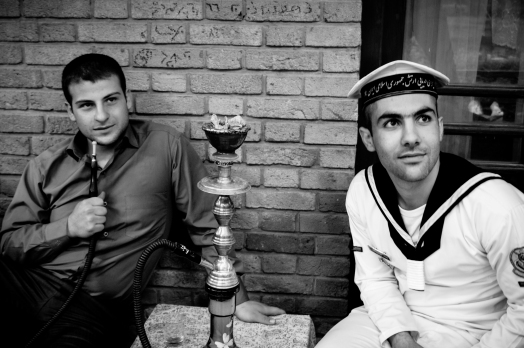
It was my first full day in Tehran, so I was unsure how to answer their question ‘Do you like Iranian girls?’ Were they trying to get me into trouble? I decided to play it safe with ‘I like all girls!’
Photograph copyright © Ben McKechnie 2010
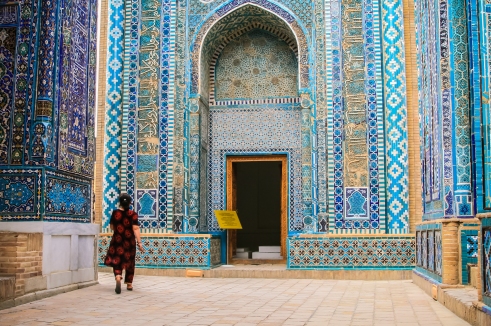
The stunning blue tiles of ancient warlord ruler Tamerlane’s capital, are still made from clay and by hand to this day. His empire once stretched all the way from Turkey right down to North India. Marveling at such beauty, it’s easy to forget that in the process of spreading his empire, he is said to have killed seventeen million people.
Photograph copyright © Ben McKechnie 2014
Brilliant, coral colored flames leap chaotically from an open fire in the middle of nowhere, attempting to lick the faces of anyone foolish enough to sit too close. There are a few. A feeling of acute isolation ebbs away with the intimate embrace of Bedouin hospitality. Khaled – the King of Petra, if nicknames are anything to go by – takes a lingering swig of gin straight from the bottle, before passing it to me.
The town of Wadi Musa, or Valley of Moses, stands as guardian of Petra. It is so named because Moses is purported to have passed though the valley with his followers. Their cracked lips and cries of thirst struck a chord in his altruistic soul and, without the need for dowsing of any kind, he struck the ground and out flowed fresh water. More than a thousand years later, the Nabataeans, the ancient people of Northern Arabia who built Petra as their capital, channeled water from this well to their city. These days, it’s a tourist town. I alight from the somewhat decrepit 250 kilometer bus service from Amman. The sound of Islamic chanting from aging speakers rings in my ears as I call Khaled to inform him of my arrival. I walk along dusty streets to reach the meeting point I’ve been instructed to go to, feeling the mild chill of a late evening in December as I walk past khaki colored buildings and shop fronts with familiar signage mixed with Arabic script. A flashy Orange cell phone store with the latest Samsung smartphone in the window stands three doors down from a fading yellow shop sign advertising Kodak 35mm film. Technology at least a decade apart, from obsolete to ultra modern, in the space of a few buildings. How quickly times change. Arriving at the roundabout in the center of town, I wait.
As it is in so many Middle-Eastern countries, the people of Petra and its surroundings come to you. Whether it’s sitting on the grass in Esfahan’s Naqsh-e Jahan Square in Iran, sitting in a tea shop smoking shisha in the Kurdish city of Van in Turkey’s far South-East, or frittering away time by the side of a road here in Wadi Musa; all you need do is wait. Well-preserved ancient ruins and natural beauty aside, it’s the people that keep you coming back to this part of the world. Around every corner is a selfless invitation to a family home, an offer of tea and a surprisingly frank discussion about almost any topic of conversation that you choose to pursue.
Loitering under a bright red and blue advertisement for Pepsi, I have my first encounter with one of Petra’s Bedouins. He saunters up with a swagger, wearing an army green shirt adorned with pin badges that hangs open four buttons to reveal a white vest. Covering his lower half are baggy, jet black Thai fisherman pants. On his head is a kuffiyeh, a traditional head cloth in the Jordanian style with a red and white hound’s tooth pattern. He introduces himself as Zay – a moniker – but a moniker which has stuck so hard he refuses to reveal his true name. Zay doesn’t take the local tradition of outlining one’s eyes with rims of charcoal lightly. It appears as if a neat yet overly zealous toddler has traced his eyelids with a beefy, black crayon. “Western women really love it”, remarks Zay with a knowing smile. I tell him that’s because he looks exceptionally like a well-known pirate from contemporary pop culture. “My friend, you know too much.” Deeply tanned skin and hair bordering on dreadlocks seal the deal. After the exchange of pleasantries, we broach deeper subjects. He’s one of the first Jordanians in a week that has lasted five minutes without hinting at how the Dinar bills in my wallet can become theirs. He acknowledges this with a look that is half regret, half pride. “We are different from city people”. Why? “Because of the mosque. We do not pray in them. We pray in our homes or outside in the desert. Money and mosque go hand in hand. It’s not our obsession. I make enough honest money from tourists with my job in Petra. If I come to you on the streets of Wadi Musa, then it’s because I feel like talking to you.” I bid Zay farewell with a handshake, just as a bright, Barbie pink Daihatsu jeep screeches drunkenly onto the roundabout. It’s not the regal sort of automobile Khaled the King would be seen in, that’s for sure.
Leaving Wadi Musa behind, South Korean manufactured pick-up trucks and brightly colored, Japanese miniature jeeps drive along curving desert roads, baking in lack of shade. Such vehicles must occasionally dodge a stray sheep or small child that has drifted into the road from a nearby Bedouin camp. In a land not blessed with fecund soil, the two main camps visible along this eight kilometer drive are built around the bases of the only two trees in sight. With tiny settlements radiating away from their trunks, the trees become symbols of fertility to be worshiped amidst their barren but beautiful surroundings.
Siq al-Barid, or Little Petra, is situated eight kilometers from the main archaeological behemoth of Petra. I discover that questions requiring facts as answers are met obliquely around here. How wide is this passageway? “As wide as a camel with medium fat. No more, no less”, comes the riposte. It serves me right for asking something so obtuse. All Khaled and his family need to know is whether or not they can shove a camel up here without lubrication. Emerging from the narrow shaft, you find yourself in an ancient suburb of Petra that was used as a trade and supply post. A petite, rock-hewn temple can be seen midway up a canyon wall, surrounded by formations resembling baked potatoes stacked atop one another. Giant hands have seemingly had fun kneading these over-sized tubers and have molded deep, concave thumbprints into their surfaces. Sights aren’t as grandiose as big brother’s down the road, but what Little Petra lacks in spectacle, it makes up for in intimacy.
Petra plays host to a thousand colorful characters, but if you were to meet just three then you could do a lot worse than Khaled the King, Ghassab al-Bedouine and Priscilla al-Daihatsu. An unholy trinity – two parts man, one part machine. I secretly christen my Bedouin hosts’ Barbie-pink mini jeep Priscilla, because I can’t decide on its gender. Unquestionably, it’s a queen of the desert, but is it all woman or more flamboyant man in drag? Either way, it oozes personality and only a small amount of engine oil; the kind of unfaltering beast, that even after 170,000 miles on the clock, can still take a daily thrashing without even so much as a whimper of complaint. The ride is fun for everyone. Priscilla’s backseat passengers must scramble and squeeze behind a driver’s seat that has given up on sliding forwards. They must then spend the duration of the journey using an arm to hold up the ceiling of the car, or instead be forced to sit leaning forwards at a spine-deforming one hundred and thirty degree angle. The car upholstery is pink throughout. The chassis is emblazoned with stickers and underneath the exhaust is partially held on with layers of duct tape. Once seated uncomfortably, Ghassab starts the engine. The jeep’s one working headlight flickers on, before roaring into the night.
Khaled is nicknamed the King either because his father is the chief of the entire Bedouin tribe, or because he owns one of the highest shops inside Petra, situated fifty steps before the top of the long climb up to the monastery. He is thirty-four, divorced and likes gin. Ghassab is Khaled’s cousin – one of hundreds – and is the owner of a giant boulder in the middle of nowhere. He is forty-two, divorced and likes chocolate. Ghassab was twenty-four when, in 1993, he met a beautiful girl from Germany. He courted her using all the tricks in the proverbial book and a week-long, whirlwind love affair ensued. Nights spent talking and laughing in secret mountain caves, huddled up under camelhair blankets, lying next to an open fire – thousands of years of which has left entering many of Petra’s caves feel like climbing inside of a lifelong smoker’s lungs, their ceilings inches thick with sticky black residue – but Ghassab forgot the golden rule of holiday romance – do not fall in love. She reciprocated however, and on a whim he flew to Germany with her where they married and lived for almost eighteen years. They divorced in 2011 and Ghassab returned to Jordan with dreadlocks, a love for Bob Marley, and a fair idea of how he wanted to live out the remainder of his life, here in the place of his birth. “I was born in a cave in Petra. I’ll die in one too”, he says, sucking on a Marlboro Red.
Their joint decision to turn a giant, hollowed-out boulder – roughly fifteen kilometers into the desert from Petra – into a livable home, was a reaction against the increasing modernization of the lives of Petra’s Bedouin tribe. In the last ten years, they have witnessed their families being moved out of camps and into ‘Bedouin villages’ – tiny towns of brick and cement houses, with a paved road and running water in the courtyards. Khaled’s English is stilted and slow as he tells me about the traditional life of his tribe. “We are used to living simply with nature. We only need the basic essentials of life. Food, water, a roof over our heads, and good company, which God provides for us in the desert”. This is juxtaposed against a back-story of roofs over heads provided by the Jordanian government. Moving into houses made of bricks must have been a sad day for Khaled and his family.
What they have achieved with their cave in the space of a few years is already impressive, but they aren’t done yet. The resourceful pair have plans for self-sufficiency; solar panels and composting toilets being at the top of the list. They try to never turn away a traveler in need of a place to stay. Neither do they charge a single dollar, despite knowing people would pay good money for this experience. “It has always been the way. Hospitality is rooted in our religion and charity is one of the five pillars. We were couch surfing before the Couchsurfing website was invented. Now we call it cave surfing”. It’s an adventurous eco-traveler’s dream, reachable only by 4×4, and only then if you know its exact location. Priscilla, Queen of the Desert, swings a right turn off the main road and then for twenty minutes traverses challenging terrain; dangerously steep inclines and vicious bumps that are absorbed by spines in place of the vehicle’s knackered suspension. Arriving at night, there isn’t any way of telling how magnificent your environs are. Through the cave’s doors you’re met with aromas of cooking, chain-smoked cigarettes and clothes that haven’t been washed in a week. But it is unarguably a home. Outside in the morning, you are met with a vision of paradise. The cave sits with palatial elevation overlooking an expanse of ochre land, while all around are fifty meter cliffs. Intense colors flood retinas and you’re bathed in complete silence. Ghassab breaks it with a shout. “Go free, my friend! Nature is your toilet!”
If there were any doubts about Khaled’s claim to being local royalty, a trip with him inside ancient Petra quickly disperses the last seeds. Other Bedouins are in deference to him. His guests are spared the hard-sell tactics of men with donkeys looking to take them for a ride. Even when Khaled isn’t leading me around, somehow it feels as though every Bedouin I meet still knows I’m his guest. Climbing a mountain, a Bedouin girl invites a friend and I to sit. Her name is Noora and she’s thirteen years old. She doesn’t attend school anymore. Her eyes are defined with thick rims of charcoal and around her head she wears a tight black headscarf. Noora calls to her younger brother and sister who,grinning cheekily, carry over a large silver tray holding lunch. “Please, eat with us”. Fried potatoes and tomatoes seasoned with herbs and salt are scooped up using flat-bread, all washed down with sweet tea infused with mint. Noora decorates my companion Sara’s eyes, before giving us some small plants called a-his-lan. Not a penny is asked for and their three grinning faces wave to us as we continue the climb.
Nobody can agree on the exact number of steps up to the High Place of Sacrifice, but they do agree that it’s at least eight hundred. Puffing and panting in the afternoon heat, climbing past altars once used for the bleeding and burning of animals – and possibly humans – the reward is a head-spinning three hundred and sixty degree view. To the south-east is the treasury, invisible up here, but to the north-west is the rest of Petra. To the east is Wadi Musa, its streets like creeper vines growing up the hill, making you feel very small indeed.
The year 2012 marked the two hundredth anniversary of Petra’s rediscovery by the explorer Johann Burckhardt, but from my high vantage point I prefer to consider its future. Whereas much of the Middle-East continues to experience uncertainty, Jordan is often seen as a beacon of stability, surrounded by politically volatile neighbors. So despite there being a civil war on next door, don’t be put off visiting Petra and the rest of this intoxicating country.
Back at the Bedouin cave, I climb the outdoor stairs carved into the rock. Together with a Swede named Gustav, we stand on top and survey the moonlit scene. The cliffs form a natural auditorium and it feels as though we are the Pope and his entourage, looking out across Saint Peter’s Square. “What would you preach if there were one million people down there right now, waiting to hear you speak?”, I ask him.He thinks about it for a minute. “I’d remind them that we’re all infinite”. Deep, man. But Gustav can’t help being an idealistic, twenty year old hipster. Tonight there’s almost some meaning in those words. Maybe in the deserts of Petra, moonlight and perfect silence make philosophers of us all.